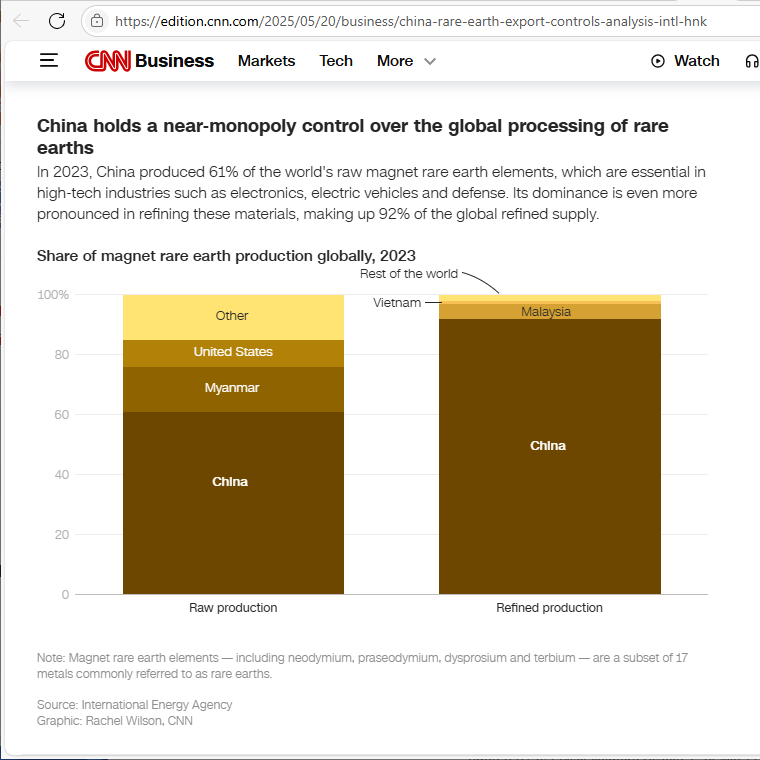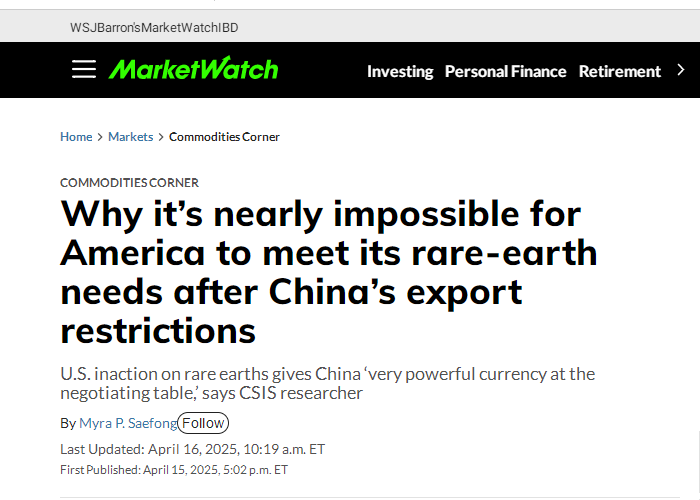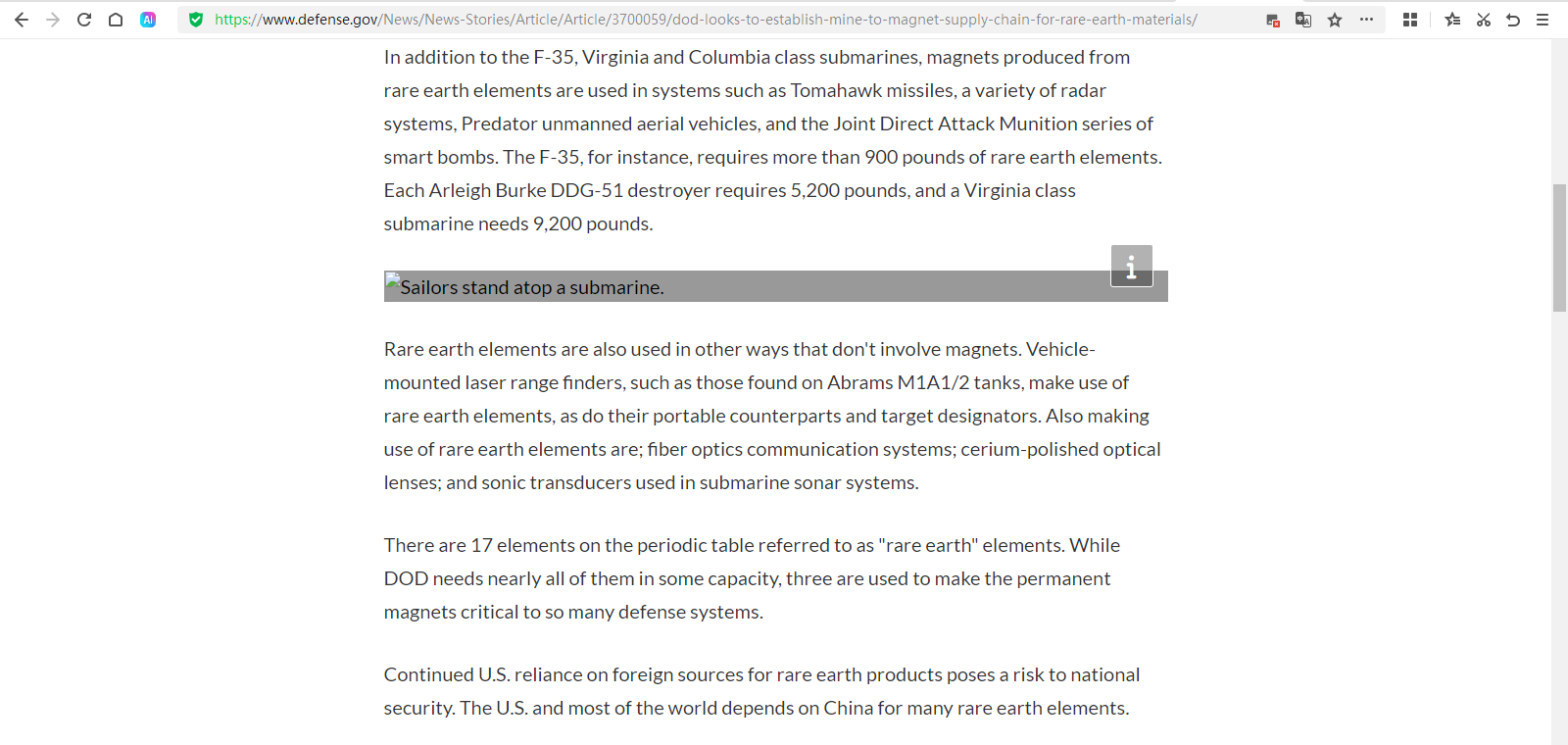西蒙尼.高
世界稀土产地历史变迁和背后的高污染风险,稀土生产也是最早转移到中国的产业。认为稀土提炼难度很高,显然对技术和历史一无所知
版主: Softfist
#24 Re: 世界稀土产地历史变迁和背后的高污染风险,稀土生产也是最早转移到中国的产业。认为稀土提炼难度很高,显然对技术和历史一无所知
即使愿意,工艺需不断改进,非常耗时。西方环保法律逆转更是难题,转移国外会有衍生问题。
最大的难题还是具有可开采性的重稀土分布。
#27 Re: 世界稀土产地历史变迁和背后的高污染风险,稀土生产也是最早转移到中国的产业。认为稀土提炼难度很高,显然对技术和历史一无所知
这玩意儿在你没有替代品的时候就是一张大牌,就像土工最近压迫袋鼠铁矿石结算的问题,没搞定非洲和巴西铁矿之前袋鼠是不可能答应的。
#37 中国在稀土领域的统治地位 -- CNN与纽约时报等的报道
今年上半年,特朗普发动贸易战、向多个国家加征关税时,CNN等美国媒体就报道,中国在稀土领域具有统治地位。
纽约时报特别强调钐(samarium)对军工的重要。中国垄断了钐金属的全球供应,钐制品几乎全部用于军事领域。
https://edition.cnn.com/2025/05/20/busi ... s-intl-hnk
For decades, the U.S. and other countries have been dependent on China's supply of rare earth minerals, which are difficult, costly and environmentally polluting to extract and process. China accounts for 61% of global mined rare earth production, but its control over the processing stage is much higher at 92% of the global output.
Magnets made of heavy rare earth elements are essential parts of everything from iPhones and electric vehicles to big weapons like F-35 fighter jets and missile systems. Yet their supply is completely dominated by China.
https://www.marketwatch.com/story/why-i ... s-2eb2cb56
In the near term, it's not possible for the U.S. to meet its own needs for the rare earths included under China's export restrictions, said Luisa Moreno, a director at Defense Metals Corp. The U.S. produces virtually "none of the materials that have just been restricted." For the U.S. to be able to produce its own heavy rare earths, it may take five to 10 years in the best-case scenario, Moreno said.
"China processes near 100% of these heavy rare earths," said Gracelin Baskaran, research director at the Center for Strategic and International Studies, "We currently do not have any capability to do this domestically."
"It's not just a capital problem. It's a know-how problem" for the U.S. and other countries, Baskaran said, "there are parts of the rare-earths supply chain … that we never actually learned how to do."
https://www.nytimes.com/2025/06/09/busi ... -jets.html
https://cn.nytimes.com/business/2025061 ... hter-jets/
中国垄断了钐金属(samarium)的全球供应,这种鲜为人知的稀土金属几乎全部用于军事领域。钐钴磁体能在足以熔化铅块的高温下保持磁力不衰减,对导弹整流罩等狭小空间内高速运转的电机耐热性能至关重要。
中国向欧美汽车制造商发放含镝、铽两种受限稀土的出口许可,这类用于刹车和转向系统的磁铁可耐受临近汽油发动机的温度,但无法满足军用级别的高温需求。然而,没有迹象表明中国批准钐的出口,因为钐的民品应用很少。
冶金学家、长期专注于钐钴磁体研究的斯坦利·特劳特(Stanley Trout)指出:“中国限制出口的七种稀土金属中,有六种主要需求来自民用领域。”他说,“钐则不同,它几乎完全用于军事目的。”钐在美国的主要用户是航空航天和军事承包商洛克希德·马丁公司,每架F-35战斗机上大约要使用23公斤磅钐钴磁体。
拜登政府曾因担忧钐供应安全而签订了两个钐设施的大额合同,但因商业可行性搁浅,导致美国完全依赖中国。
#38 Re: 世界稀土产地历史变迁和背后的高污染风险,稀土生产也是最早转移到中国的产业。认为稀土提炼难度很高,显然对技术和历史一无所知
70年代稀土精炼大概是90%的纯度,难度确实不大
现在中国能做到99.999%,其他国家没这技术
70年代中国也能做光刻机, 美国则是光刻机的引领者,不代表中国和美国能做阿斯麦的最先进的光刻。
美国公司现在是99.9%的水平,当然能满足很多需求,但是有些高端需求就差太远了,纯度差异会带来巨大的性能差异,其实这和光刻机的情况有相似之处的。








